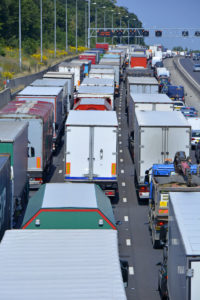
Even though capacity is at an all time high, congestion and truck rates are increasing on pace, especially on the East Coast where the dense urban landscape, growth in e-commerce deliveries and limitations on pickup and delivery times work as a perfect storm for trucking nightmares. Through the past summer, truck driver hiring reached an all time high, alongside the orders for more new trucks – a similar situation to the exponential growth or ride sharing usage among Uber and Lyft. Unfortunately, few companies, cities and delivery points are able to order more roads, docks and hours of delivery as easily as they can trucks and drivers.
 For years we’ve been talking about the boon of e-commerce, dedicated shipments and final mile delivery as the numbers have risen across the nation. The key point in expansion is occasionally lost in review; that more trucks can carry more cargo, but the routes and deliveries can’t get any larger to accommodate the increase in traffic. Increases in capacity do not always translate into faster transport or lower rates.
For years we’ve been talking about the boon of e-commerce, dedicated shipments and final mile delivery as the numbers have risen across the nation. The key point in expansion is occasionally lost in review; that more trucks can carry more cargo, but the routes and deliveries can’t get any larger to accommodate the increase in traffic. Increases in capacity do not always translate into faster transport or lower rates.
Other issues impacting the trucking market, specific to the East Coast, include the recovery efforts after Hurricane Florence slogged through the Carolinas and tense bottlenecks around the nation’s busiest ports and delivery centers. Experts following these trends don’t expect there to be any significant relief until the second half of 2019.
Avery Vise, Vice President of Trucking for FTR|Transportation Intelligence, explained, “Conditions likely are approaching their most favorable for carriers in the current cycle, as additional drivers and trucks as well as ongoing supply chain adjustments to tight capacity and electronic logging devices should bring modest stabilization. However, given strong manufacturing and construction activity, stimulus from government spending and tax cuts, and a very tight labor market, trucking conditions for the next year should remain stronger than at any point from 2015 through 2017.”







